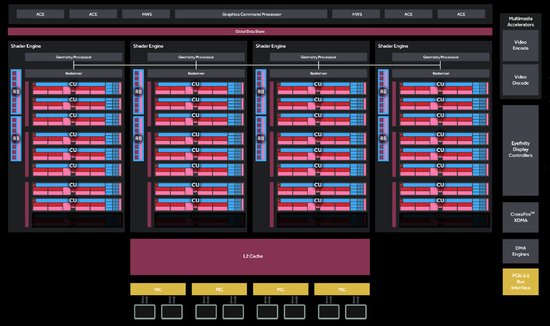Architettura Polaris 10 PRO
La Radeon RX 470 utilizza la versione depotenziata del chip Polaris 10. Rispetto a Polaris 10 XT (RX 480) sono state disattivate 4 CU ed è stata abbassata la frequenza di clock. Complessivamente all'interno di Polaris 10 PRO troviamo abilitate 32 CU (2048 SPs) che funzionano ad una frequenza di base/boost pari a 926/1206MHz.
Per il resto la GPU è identica al modello XT: integra 4 motori geometrici, 4 ACE , 2 unità HWS,.32 ROPs ed un controller delle memorie a 256-bit.
Per distinguerla dalla sorella maggiore AMD ha praticato un downlock anche sulle memorie video, abbassandole da 7000MHz a 6600MHz (versione 4GB). Tutte queste modifiche hanno permesso di ridurre il TBP (Typical Board Power) di 30W rispetto alla RX 480.
| Radeon RX 470 (referecence) | |
| GCN Architecture | 4th Generation |
| Manufacturing Process | 14-nm FinFET |
| Die Size | 232 mm2 |
| Transistors | 5.7B |
| Compute Units | 32 |
| Stream Processors | 2048 |
| Clock Speeds (Boost / Base) | 1206 MHz / 926 MHz |
| Peak Compute Performance | Up to 4.9 TFLOPS |
| Texture Units | 128 |
| Peak Texture Fill-Rate | Up to 154.4 GT/s |
| ROPs | 32 |
| Peak Pixel Fill-Rate | Up to 38.6 GP/s |
| Memory Size | 4 GB |
| Memory Bandwidth | 211 GB/s |
| Memory Interface | 256 bit |
| Memory Type | GDDR5 |
| Board Power | 120W |
| AMD FreeSync Technology | Yes |
| DirectX 12 Support | Yes |
| Vulkan Support | Yes |
| VR Premium | Yes |
| DisplayPort Version | 1.3 HBR / 1.4 HDR Ready |
E' interessante notare come Polaris 10 PRO proponga lo stesso numero di unità funzionali di Tonga XT: l'unica differenza tra i due chip è il quantitativo di cache L2 (2MB vs. 512KB) e , ovviamente, il processo produttivo (14nm vs. 28nm). A tal proposito stiamo preparando un confronto diretto tra P10 PRO e Tonga XT con frequenze normalizzate per valutare le effettive differenze tra l'architettura GCN4 e GCN3.

